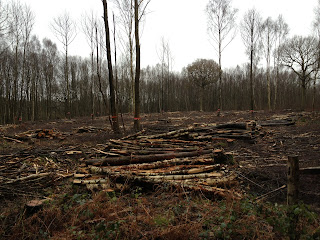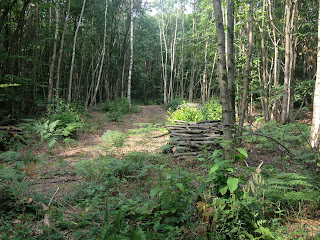Well, we haven’t of course, but we have
cleared about an acre this winter.
This is coppicing and it is essential for
the health of the woodland and the insects, birds and plants that live in it. The trees will recover
really quickly – this is what happens after the first year
Silver Wood is in Old Park Wood, a
semi-natural ancient woodland of coppiced sweet chestnut and oak standards with
invasive birch. What does that mean?
The semi-natural refers to the fact that
the woodland has been managed throughout its recent and more distant history.
Chestnut isn’t a true native tree in the UK and some people think it was
brought over by the Romans. Whether that is true or not, it was certainly
planted and before chestnut there may have been hornbeam or hazel.
The ancient designation is because the wood
has been woodland for as long as records exist, which in our case go back to
the 17th century or so. In fact the borders of the wood haven’t
changed from when they were first drawn on a map and its quite possible that
the wood has been woodland all the way back to the original wild wood or weald.
The chestnut is an understory tree – that
is, it was grown for some time, typically 10-15 years and then cut down at its
base when it springs up again with many shoots. This gives it the typical
appearance of a coppiced tree and these cut and regrowth cycles can be
maintained for a very long time meaning the small trees you see in our wood are
just the latest shoots from an organism that might be a hundred or more years
old.
The standards are the oak trees that are
scattered about the wood. These would have been planted for constructional
timbers and before that for warships – Britain’s walls of oak – many of which
were built in the Chatham dockyards not so far away. Apparently Henry VIII made
a law that all woodlands had to have oak standards to maintain supply for the
Navy. A medieval version of military drivers for the economy I guess.

The silver birch is a natural early
invasive species and the fact that we have so much of it reflects the fact that
the wood has been pretty much neglected for a decade or two. Coppicing the wood
has real benefits for biodiversity as it performs the same function as forest fires in
places like Australia or North America in removing the canopy trees that
prevent light from reaching the ground. Coppicing, and the light it brings,
allows a whole range of flowering plants to spring up and this attracts insects
and then these bring in the birds. As the trees grow up the young coppice
provides nesting and hiding places for the birds.

In the distant past the wood had a
substantial economic value (as well as Henry’s military value). It was owned by
the Glassenbury estate, the estate and house behind the Peacock inn. The wood
was used as a fuel supply and probably livestock feed (the leaves, acorns and
chestnuts would all have been used for pigs and other animals) and would have
generated income from products such as charcoal and timber. The earliest map
shows the wood as a fenced area – a forest – suggesting it was also used for
hunting. A reference to the charcoal can still be seen in the name of the road
and school next to the wood – colliers green. Later the wood was used for hop
poles and fencing but as the hop industry took a serious knock and as people
turn to less labour intensive fencing, value of the wood products fell and the
coppicing stopped maybe 15-20 years ago.
Now we are trying to improve the
biodiversity by opening up the rides (paths) and wherever possible reinstating
a coppice cycle. Last winter Peter Twedell coppiced a whole acre. A fantastic
bit of kit loaded onto a tractor made light work of the trees.
You can see the bluebells benefiting from
the new, light woodland where it has been coppiced
What makes this now economically viable is the cost of gas and oil and the growth of wood burning stoves. This is the last of four stacks of poles
about to go off for kiln drying after which they will be sold by Peter’s
company (http://www.bertieswoodfuel.co.uk/) for firewood.
I cant keep up with the tractor but you can
see the effect of a little light forestry on the rides here – see the growth in
the first spring up to the line of standing trees where it all goes dark again
Last year I heard the first nightingale in
the wood, and flushed lots of woodcocks that like the cover the new coppice
growth brings, and we saw more orchids than we have seen before.
Its good to
see the woods coming back to life. Which is why we have chopped some of the
trees down…..
























